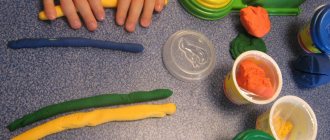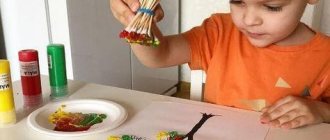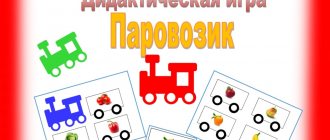Didactic games in the development of visual creativity in preschool children
The formation of a creative personality is one of the most important tasks of pedagogical theory and practice at the present stage. Encouraging creativity is especially important in preschool years. It is the preschooler whose whole life is permeated with fantasy and creativity. Without proper development during this period, creative potential will not always manifest itself in the future. In the history of preschool pedagogy, the problem of creativity has always been one of the most pressing. After all, creativity is one of the meaningful forms of mental activity of children, which can be considered as a universal means of individual development, ensuring sustainable adaptation to new living conditions, as a necessary reserve of strength for overcoming stressful situations and an active creative attitude towards reality.
The main motive of children's creativity is the desire to express their impressions and experiences, and to master them in activities. Great potential for revealing children's creativity lies in visual activities. Namely in drawing.
This is true! Well, what is there to hide?
Children love, love to draw!
On paper, on asphalt, on the wall,
And on the window on the tram.
E. Uspensky.
How can we achieve positive results in mastering fine arts skills so that every child’s work can feel originality and creativity? In our opinion, with the help of unconventional drawing methods you can develop your child’s imagination unnoticed, and didactic games will help develop creative abilities. Even a low-active child, imbued with an interesting and new activity, makes his first successes.
Children's play attracts the attention of researchers as a multifaceted problem. Game as a social phenomenon, as a means of education and training has always attracted the attention of scientists, psychologists, and teachers. P.F. Lesgaft also noted that a child is a mirror of the environment in which he grows up. Consequently, a child’s play is a reflection of the level of culture of society.[3, p. 417]
For the development of visual skills in preschool children, artistic and didactic games and exercises are appropriate that help children better understand the meaning of the educational task and understand how to perform actions [2, p. 208]. The duration of one game is 5-10 minutes. Artistic and didactic games can be divided into conditional groups:
1. Games that promote the development of graphic skills and understanding of the design features of the form. By playing these games, children develop spatial imagination and learn to recognize an object by its individual properties and parts. For example: “Assemble a figure from a picture”, “Shapes”, “What does it look like”, “Recognize an object by its silhouette”.
2. Games that develop color perception in children, facilitating the implementation of pictorial and coloristic learning tasks. For example: in the game “Warm - Cold”, we clarify with children the concepts of “warm and cold colors”; in the game “Beautiful Flowers Bloomed in the Meadow,” children collect bouquets of flowers of a certain color scheme: warm or cold; In the games “Autumn Palette”, “Spring Palette”, “Seasons”, children select a color scheme for a certain time of year and consolidate knowledge about seasonal changes in nature.
3. Games that reinforce knowledge about the properties of an object: their color, shape, structure, size. For example: in the game “Paired Pictures” you need to find the similarities and differences between objects; When playing the “Animals” construction set, children assemble a whole animal from various parts of the body (head, ears, torso, paws, tail).
4. Games to develop a sense of rhythm and symmetry. In these games, children learn to independently compose patterns, taking into account the spatial relationships between its elements, maintain symmetry and ri, “Continue the ornament,” “Compose a pattern from the proposed elements.”
5 . Games that promote the development of compositional skills, starting from the uniform arrangement of objects on a sheet of paper in drawing and applique with a conscious combination of objects in shape, color and size. For example: “Make a still life”, “Complete a picture”, “Perspective”. In these games, children learn to perceive such characteristics as far, close, there, here, top, bottom, right, left, in front, behind, around, to the side [1, p. 65].
Thus, in the process of didactic games, preschoolers master many practical skills that will later be needed to perform a wide variety of jobs, and acquire manual skills that will allow them to feel independent.
Literature:
- Komarova T.S. Preschool age: problems of development of artistic and creative abilities. [Text] / Komarova T.S. // Preschool education. 1998, No. 10. - p.65-67
- Sakulina, N.P. Visual activities in kindergarten: A manual for educators. - 2nd ed., revised. and additional / N. P. Sakulina. – M.: Education, 1982. – 208 p.
- Artistic creativity and the child: book. for education det. garden / ed. N. A. Vetlugina. – M.: Education, 1982. – 417 p.
Card index of didactic games for visual arts
Ekaterina Feklistova
Card index of didactic games for visual arts
Didactic game “Magic Colors”
Goal: during the game, to develop children’s attention and interest in various colors and shades, a feeling of joy when perceiving the beauty of nature.
Material: cards with different colors.
How to play: Give children cards with squares of different colors. Then the teacher says a word, for example, birch. Those children who have black, white and green squares raise them up.
Then the teacher says the next word, for example, rainbow, and the squares are raised by those children whose colors correspond to the colors of the rainbow. The children’s task is to respond as quickly as possible to the words spoken by the teacher.
Didactic game “Funny Colors”
Goal: to introduce children to primary and composite colors, the principles of color mixing.
Material: cards with pictures of girls-paints, signs “+”, “-”, “=”, paints, brushes, paper, palette.
Progress of the game: Children are asked to solve examples by mixing colors, for example, “red + yellow = orange”, “green + yellow = blue”.
Didactic game "Caterpillars"
Target. Exercise children in determining warm or cold colors, in the ability to arrange colors in shades from light to dark, and vice versa.
Material: colored circles of warm and cold colors, image of a caterpillar's head.
Progress of the game. Children are invited to use the circles provided to create a caterpillar with a cold color scheme (warm) or a caterpillar with a light muzzle and a dark tail (dark muzzle and light tail).
Didactic game "Balls"
Goal: to develop in children the ability to perform circular movements when drawing a ball in a closed circle, relying on visual control and with their eyes closed.
Progress of the game. The teacher invites the children to look at a panel in which a kitten plays with balls of thread that he has unwound. Then he invites the children to collect the threads into a ball and shows how the threads are collected into a ball, imitating with the movements of a pencil winding the threads into a ball.
Periodically, the teacher invites children to close their eyes and perform movements with their eyes closed.
In order for children to show interest in work, you can give them the opportunity to draw a lot of balls, arrange a competition: who can draw the most balls.
Didactic game "Matryoshkin's sundress"
Purpose of the game: to develop compositional skills, consolidate children’s knowledge about the basic elements of painting a Russian nesting doll, and consolidate knowledge of Russian national clothing.
Progress of the game: Silhouettes of three nesting dolls are drawn on the board, the teacher calls three children in turn, they each choose to wear their own nesting doll.
Didactic exercise “Let’s draw how the plates are located on the table”
Goal: to train children in drawing round and oval shapes, to develop the ability to distinguish objects by size from large to small.
To complete the exercise, children are given stencils with slots for three circles of different sizes and slots for three ovals located between the circles. The ovals are also of different sizes, with handles attached to them.
Progress of the game: The teacher says: “Children, three bears came to visit us. Let's give them a treat. For this we need dishes: plates and spoons.” The teacher shows the children stencils and suggests tracing circles and ovals, and then adding handles to the ovals to make a spoon.
After completing the task, the bears and the children watch how all the work is done and compare it with the real table setting, where the plates and spoons are located. Here you can also clarify which side of the plate the spoon is located on.
Didactic game “Collect and count nesting dolls”
Purpose of the game: to consolidate knowledge about the Russian nesting doll, develop the ability to distinguish this type of creativity from others, develop ordinal counting skills, eye, and reaction speed.
Progress of the game: Leaves with drawn silhouettes of nesting dolls hang on the board, three children are called and they must quickly arrange the nesting dolls into cells and count them.
Didactic game “Who will draw the most oval-shaped objects?”
Goal: to strengthen children’s ability to quickly find similarities between ovals located horizontally, vertically or diagonally with whole objects of the plant world or their parts, and complete the images.
Progress of the game: draw at least 5 images of plants in ovals, color them in the appropriate color, while combining various visual materials to complete the resemblance to the original.
Didactic game “Who plays hide and seek with us”
Goal: to teach children to compare the color and background of a picture with the coloring of animals, which allows these animals to be invisible against this background.
Progress of the game: take two cards of different colors, name animals with similar colors; Having received the figure, circle it on the desired background. The winner is the one who gets the most figures, and also draws suitable animals that the teacher did not have.
Didactic game “Draw a warm picture”
Purpose: to clarify with children the concepts of “warm and cold colors”; continue to learn how to compose a picture from memory, using warm colors when coloring.
Materials: 4 pictures depicting simple plots, geometric shapes found in these pictures, colored pencils, felt-tip pens, sheets of white paper.
Progress of the game: after carefully examining the uncolored sample picture, at the teacher’s signal, turn it over, depict the scene you saw on your sheet of paper, and color it, adhering to a warm palette.
Game actions: depicting a plot from memory, completing small details, using unconventional drawing methods to add individuality to your work.
Creative tasks:
A) draw a “warm” still life;
B) tell me what is orange (pink, red, yellow);
B) paint your clothes in warm colors. What vegetables and fruits come in the same color?
Didactic game “Painted Horses”
Goal: to consolidate knowledge of the main motifs of Russian folk paintings (“Gzhel”, “Gorodets”, “Filimonovo”, “Dymka”), to consolidate the ability to distinguish them from others, to name them correctly, to develop a sense of color.
Progress of the game: the child needs to determine in which clearing each of the horses will graze, and name the type of applied art based on which they are painted.
Didactic game "Portraits"
Goal: teach children to draw a head using templates.
Materials: a sheet of paper with a drawn oval of the face; cardboard templates of eyebrows, eyes, nose, lips, ears, hairstyles.
Progress of the game: lay out the head on a piece of paper, trace it, color the resulting portrait
Didactic game “Make a hedgehog from sticks”
Goal: to learn to convey an image schematically, to distract from secondary features, conveying the main ones.
Material: counting sticks, or colored paper strips, or felt-tip pens.
Progress of the game: lay out an image with sticks or draw shelves with a felt-tip pen, or paste an image from strips.
Didactic game “Bottom of the Sea”
Purpose of the game: development of artistic composition skills, development of speech, logical thinking, memory.
Progress of the game: A very common game that can be used not only in art activities, but also in other educational areas. The children are shown the seabed (empty, and it must be said that all the sea inhabitants wanted to play “Hide and Seek” with us, and in order to find them we need to guess riddles about them. The one who guessed right hangs the inhabitant in the background. The result is a complete composition. The teacher motivates children to visual arts. (Good to use with middle and older groups). In the same way, you can study with children other themes of plot compositions: “Summer Meadow”, “Forest Dwellers”, “Autumn Harvest”, “Still Life with Tea”, etc. etc. You can invite several children to the board and ask them to make different compositions from the same objects.This game develops intelligence, reaction, and compositional vision.
Didactic game “Collect a landscape
“Using the example of a landscape, it is convenient to develop a sense of composition and knowledge of natural phenomena. To do this, it is convenient to use this didactic game.
Purpose of the game: to develop compositional thinking skills, consolidate knowledge of seasonal changes in nature, consolidate knowledge of the concept of “landscape,” develop observation and memory.
Progress of the game: the child is asked to create a landscape of a certain season from a set of printed pictures (winter, spring, autumn or winter; the child must select objects corresponding to this particular time of year and, using his knowledge, build the correct composition




